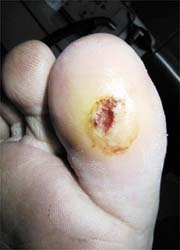Saving diabetics' feet
Diabetic foot syndrome (DFS) is one of the most serious sequela of diabetes mellitus - Disease management programmes (DMP) yield first results

DFS, described in the Wagner classification system by six grades from the initial wound to amputation, is a slowly developing condition that presents a major challenge for the medical team, which should include podiatrists and orthopaedic technicians. In Germany alone, current estimates indicate 29,000 diabetes mellitus-induced amputations annually, most of these following an infection – particularly MRSA. 10% of all diabetics with DFS will undergo a major amputation of the lower extremities, and 20% of these patients will not survive the surgical intervention.
The problem and causes of DFS
The crucial issue with DFS is the sensor and motor polyneuropathy that affects about 60% of these patients. Sensor polyneuropathy reduces pain sensitivity, which means the patient or the family notice a weeping wound on the sole of the foot only because socks or shoes are wet. Fairly often, it is only upon discovery of such a wound and subsequent consultation with a doctor that the patient realises s/he suffers type II diabetes mellitus that needs treatment. In many such cases the patients had not paid much attention to their feet and overlooked previous symptoms, such as reduced sweat secretion, excessively warm, dry, chapped and callous feet and even deformations caused by motor neuropathy. The latter atrophies the short foot muscles and causes changes in the form of the plantar arch, which in turn leads to a different distribution of pressure when walking and, consequently, to callus formation on the foot where the pressure is most intense. Often, these physical developments are ignored because they are taken as normal signs of ageing. According to a Health Care Monitoring study, patients take their bodies for granted, or maybe fall into one of the following categories:
- 21% of adults take only the most basic measures to maintain health; they consider a visit to the doctor’s surgery is an easy way out and tend to reject self-medication
- 15% of adults feel healthy; they talk and think little about their health; they know that their personal healthcare is inadequate but see no point in changing their behaviour
- 17% of adults are not interested in their individual health; they feel healthy and rarely see a doctor (Source: Health Care Monitoring, a German study involving 3,000 people.
Details: www.psychonomics.de)
According to this study 46.6% of the adult population have little or no interest in their health and react too late to a condition that would have prompted the other half of the population to see a doctor. This disinterest might explain why so many patients present with severe medical conditions. A further consequence of neuropathic disorders is diabetic neuropathic osteo-arthropathy (DNOAP or ‘Charcot foot’), which causes the plantar arch to collapse, leading to deformities due to increased pressure and callus formation.
About 30% of these patients suffer a combination of peripheral arterial disease (PAD) and diabetic neuropathy, 10% have ischaemia. In both cases the prognosis is even worse than for neuropathy due to the vascular situation and poor circulation. Vascular diagnostics and reconstruction are imperative – a fact that underlines the necessity for close cooperation between diabetologists and vascular surgeons, if the patient is to have a chance to avoid amputation.Even better: the patient can be convinced to participate in a disease management programme (DMP).
In Germany, such programmes have shown very promising results. In December 2006, the first data analyses to provide an indication as to the effectiveness of DMPs became available. In one German Federal State the condition of 44,995 patients with type II diabetes mellitus were recorded for six months (April to September) in 2006, and the study showed that very few cases of diabetic keto-acidosis had been reported. This means that diabetics in Germany are quite well prepared to avoid this dreaded life-threatening metabolic disorder. After all, 30.1% of them could get rid of typical diabetes symptoms, such as fatigue, polyuria and polydipsia (excessive thirst). High blood pressure was under control in almost 40% of them. 92.9% of the patients underwent a foot examination but only 48.6% participated in diabetes training.
These figures show that the education issue requires much more attention. This might well be the most difficult task for the medical team: The patient has to understand that he will benefit from that education and learn to control the disease and its consequences rather to be controlled by it.
Source: Phasengerechte Versorgung beim Diabetischen Fußsyndrom, Coloplast GmbH, Hamburg)
31.08.2007










